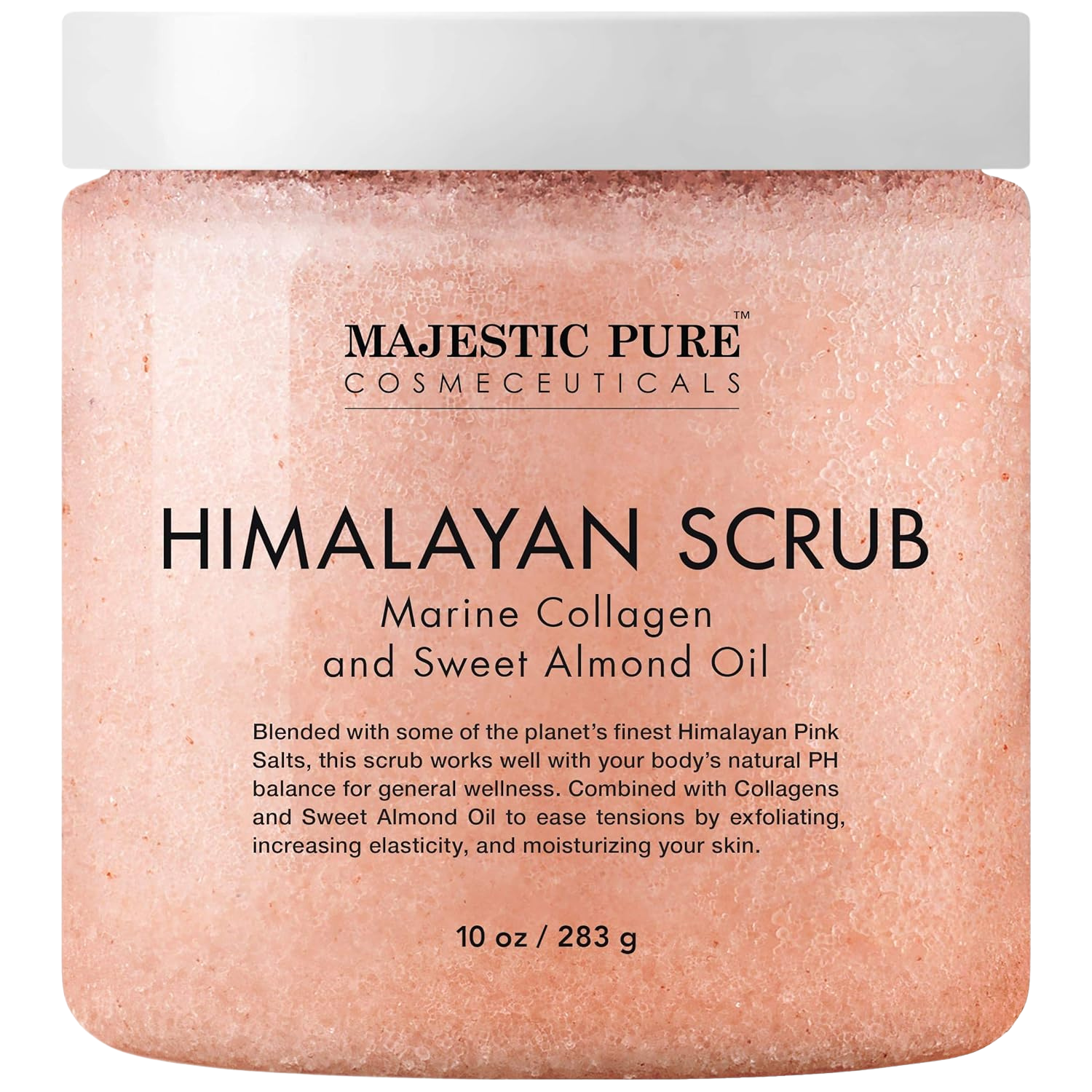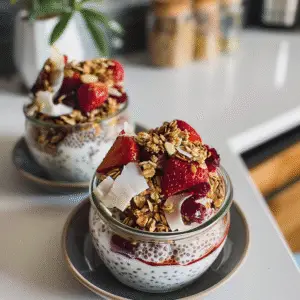Bringing nature indoors is rewarding, even with little natural light. There are many indoor plants that do well in dim places. This lets you enjoy the perks of gardening inside, no matter the size of your space.
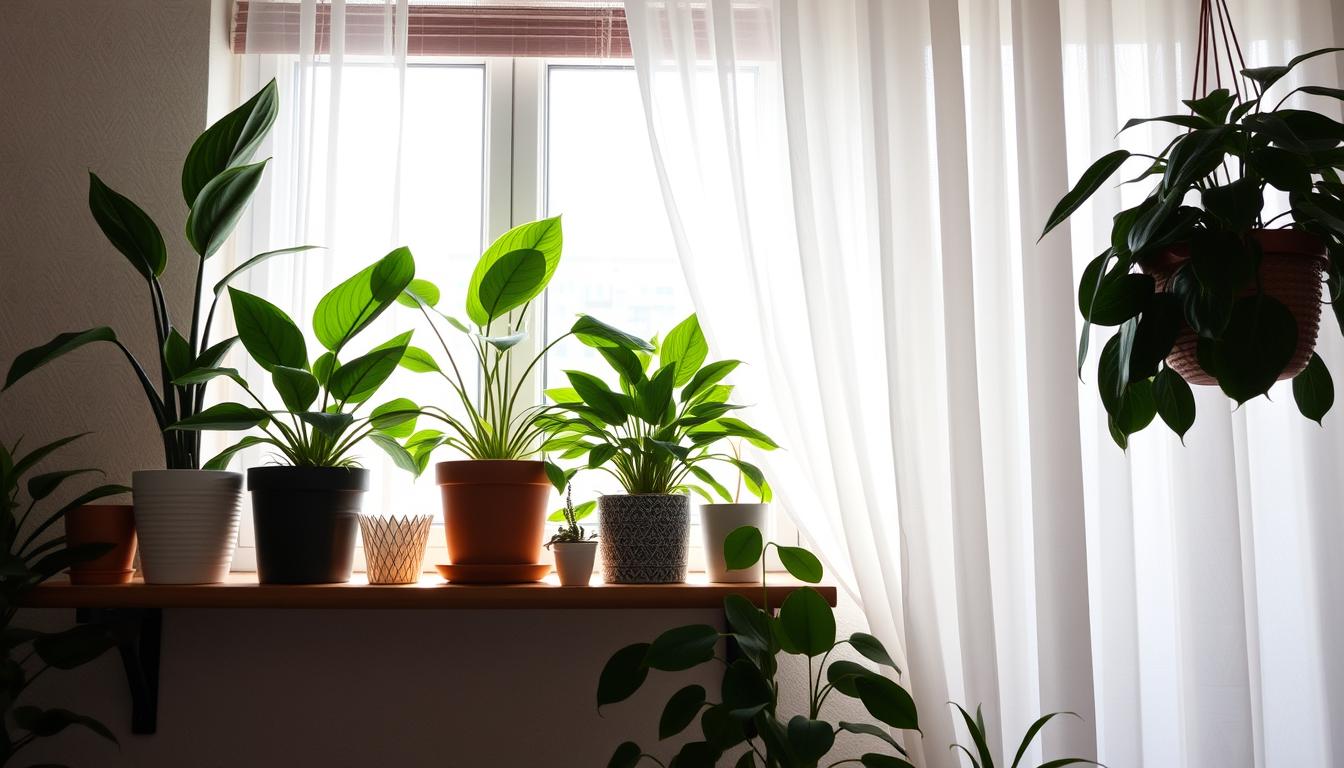
Some plants, like Dracaena, Zamioculcas (ZZ Plant), and Philodendron, love low light. Knowing about these can help you avoid common mistakes. They add beauty and improve your home’s air and mood.
Key Takeaways
- Only a few plant options thrive in low light indoor conditions.
- Many articles suggesting low light plants may not be accurate according to local experts.
- Dracaena, ZZ Plant, and Peace Lily are some of the best options for low light environments.
- Understanding specific care requirements helps prevent maintenance issues, such as overwatering.
- Creating a lush atmosphere is feasible even in spaces with minimal natural light.
Understanding Low Light Conditions
Indoor gardening comes with its own set of challenges, especially in low light areas. It’s key to know what low light means for plants. Low light spots are where direct sunlight is scarce, making it hard for many plants to grow well.
Definition of Low Light
Low light spots are where sunlight barely reaches. These areas include basements, north-facing rooms, and corners with little natural light. For those who garden indoors, knowing these spots is vital. It affects how well different plants can grow in dim light.
Common Indoor Environments with Low Light
Many indoor places often have low light. For example:
- Office cubicles with little window space
- Living rooms with thick curtains
- Basements without windows
These spots can be tough for anyone trying to keep plants alive indoors.
Challenges of Indoor Gardening in Low Light
Indoor gardening in low light faces big challenges. Plants like ZZ plants and peace lilies may grow slowly. They need careful care to thrive.
Watering is a big deal, as these plants need water less often. Too much water can harm them, causing root rot and yellow leaves. Using potting mixes that drain well can help keep roots healthy.
Benefits of Indoor Plants for Low Light
Adding indoor plants to low-light areas can make your space better and healthier. These plants not only look good but also help your health. They improve air quality, make your home look better, and help your mind feel better.
Improving Indoor Air Quality
Indoor plants clean the air in your home. Plants like peace lilies and ZZ plants remove bad stuff from the air. This makes your home air cleaner and healthier for you and your family.
Enhancing Home Aesthetics with Lush Decor
Using low-light plants in your decor can make your home look amazing. The green leaves of these plants add color and life to dark spots. They can be placed in corners or hung from the ceiling, making any room feel warmer and more alive.
Promoting Mental Well-being
Having plants indoors can help your mental health. Studies show that plants can lower stress and anxiety. Caring for a plant can also give you a sense of purpose and connect you with nature.
| Benefit | Description | Examples of Plants |
|---|---|---|
| Improving Indoor Air Quality | Absorbs toxins, releases oxygen | Peace Lily, ZZ Plant |
| Enhancing Home Aesthetics | Brings vibrancy and life to interiors | Snake Plant, Pothos |
| Promoting Mental Well-being | Reduces stress and anxiety, improves mood | Spider Plant, Peace Lily |
Top Indoor Plants for Low Light
Choosing the best indoor plants for low light can be very rewarding. The right plants not only make your home look better but also improve the air quality. Here are three great options for dimly lit areas.
ZZ Plant
The ZZ Plant, or Zamioculcas zamiifolia, is perfect for spaces with little light. It has shiny, dark green leaves that add beauty. ZZ Plants are known for being tough and needing little water, making them great for low light.
They cost about $24.95 and can even survive if you forget to water them.
Snake Plant
The Snake Plant, or Sansevieria trifasciata, is another excellent choice. It cleans the air and grows well in low light. The ‘Zeylanica’ and ‘Laurentii’ varieties are especially popular.
It costs around $16 and has striking leaves that grow upright. It can thrive in many conditions.
Peace Lily
The Peace Lily, or Spathiphyllum, adds elegance with its glossy leaves and white flowers. It’s known for purifying the air and is on NASA’s list of top indoor plants. The ‘Sweet Pablo’ variety costs about $72.
It does well in low light, making it perfect for dark spots in your home.
| Plant Name | Scientific Name | Price | Light Requirement |
|---|---|---|---|
| ZZ Plant | Zamioculcas zamiifolia | $24.95 | Low Light |
| Snake Plant | Sansevieria trifasciata | $16.00 | Low to Indirect Light |
| Peace Lily | Spathiphyllum | $72.00 | Low Light |
Learn more about plant care and how to make your home greener at Svetb. The right plants can turn your home into a peaceful and welcoming place.
Indoor Plants for Low Light: Characteristics of Shade-Tolerant Houseplants
Knowing about shade-tolerant houseplants is key for improving indoor spaces. These plants have special traits that help them grow well in dim places. They are also easy to care for, needing less water and attention.
Low-Maintenance Requirements
Shade-tolerant houseplants are great because they need little care. They don’t need to be watered often, perfect for those who are busy or new to gardening. Even if you forget to care for them, these plants can still do well. The Peace Lily and Janet Craig Dragon Plant are good examples, thriving in low light.
Durability in Dim Light Conditions
These plants are also very durable in low light. Plants like Aglaonema and Cast Iron Plant have big leaves that catch more sunlight. This helps them turn light into energy, even in dim places. They are a smart choice for areas with little light, keeping your home lively.
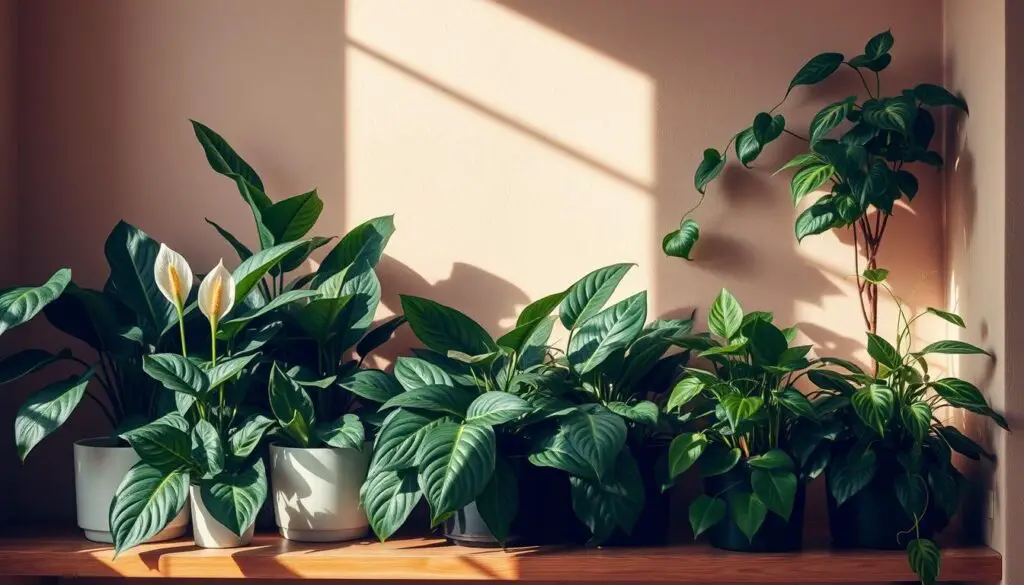
| Plant Name | Low-Maintenance Requirements | Durability in Low Light |
|---|---|---|
| Pothos | Water every 1-2 weeks | Thrives in low light |
| Peace Lily | Requires little attention | Adaptable to low light |
| Aglaonema | Few watering needs | Excellent low light tolerance |
| Cast Iron Plant | Neglect tolerant | Survives in low light |
Adding these plants to your home can make it look better and be easier to care for. Choosing plants that fit these traits can make your indoor space more beautiful and fulfilling.
How to Care for Low Light Plants
Understanding the needs of low light plants is key to their care. These plants are perfect for indoor spaces because they can grow well in little light. It’s important to know how to water them, what soil to use, and how to tell if they’re healthy.
Watering Tips for Resilient Botanical Companions
Don’t overwater low light plants. Let the soil dry out a bit before watering again to avoid root rot. Check the soil moisture by sticking your finger in it. If it’s dry, it’s time to water.
Plants like the Snake Plant and ZZ Plant need less water than others. Water them more often in spring and summer, but less in fall and winter.
Optimal Potting Conditions
The right soil is crucial for low light plants. Use a mix that drains well to prevent too much water. Adding perlite or sand to the potting mix helps.
Make sure your pots have holes for drainage. This stops water from building up. Also, choose pots that let roots grow without being too crowded.
Signs of a Happy Plant vs. a Struggling One
Healthy plants have bright colors, firm leaves, and grow steadily. They look vibrant and green. On the other hand, sick plants might have yellow leaves, droopy stems, or stop growing.
Changing how you water or repotting can help a sick plant get better. Knowing these signs helps you take care of your plants better.
Check out this link for tips on creating a healthy home, just like caring for indoor plants.
| Plant Type | Watering Frequency | Optimal Soil Type | Signs of Health |
|---|---|---|---|
| Snake Plant | Every 2-3 weeks | Well-draining potting mix | Firm leaves, upright growth |
| ZZ Plant | Every 2-4 weeks | Commercial potting soil with perlite | Vibrant green leaves, no yellowing |
| Pothos | Every 1-2 weeks | Standard potting mix | New growth, bright leaves |
| Peace Lily | Every 5-7 days | Moist, fertile soil | Blooms flowers, leaves standing tall |
Creating a Low Light Garden
Creating a low light garden needs careful thought about where to place plants and which ones to choose. By picking the right plants for dim light, you can make a welcoming space. This space will do well in cooler, less sunny areas.
Best Locations for Dim Light Plant Varieties
Look for spots in your home that get little sunlight. Shaded areas near windows or rooms with soft light are perfect. Some great places include:
- Near north-facing windows where sunlight is minimal
- In shaded corners of living rooms or bedrooms
- On shelving units with indirect light exposure
- Bathrooms with limited natural light, suitable for humidity-loving plants
Combining Plants for Visual Interest
Choosing different plants adds beauty to your low light garden. Think about the height, texture, and color of each plant. ZZ plants and Snake plants add structure, while Peace Lilies and Maidenhair Ferns bring softness. Grouping plants like Philodendrons and Chinese Evergreens makes your space look lush.
For a stunning look, pick:
- Plants with contrasting leaf shapes and colors
- A variety of heights to create dimension
- Plants such as the Cast Iron Plant and Ruby Rubber Plant for durability
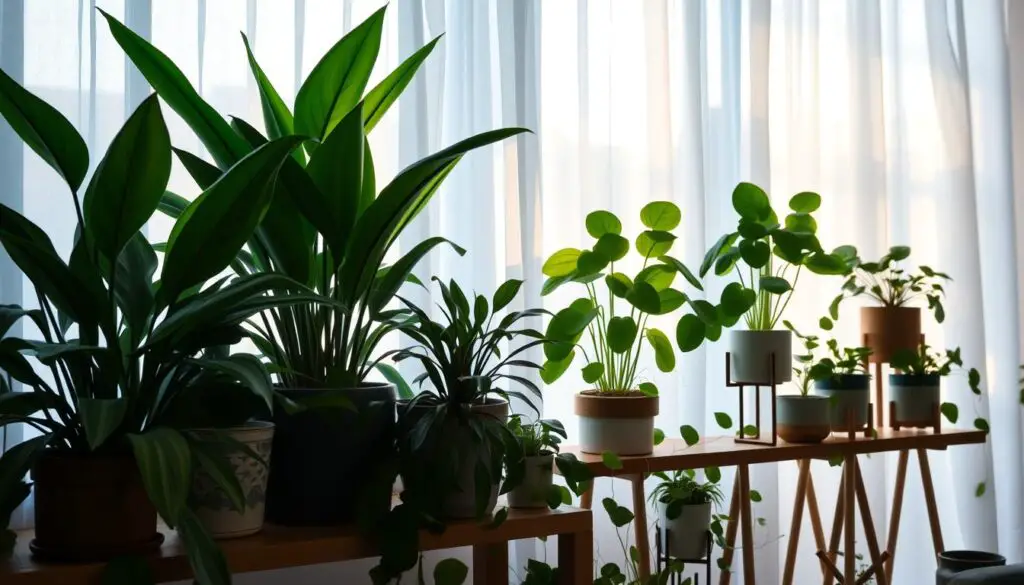
Energy-Efficient Indoor Greenery
Adding energy-efficient indoor greenery to your home is a smart move. Picking plants that do well in low light and are easy on your wallet makes your home greener and cheaper to run. These plants not only make your space look better but also improve the air quality.
Cost-Effective Plant Choices
There are many affordable plants that look great and can handle low light. The Snake Plant and ZZ Plant are top picks because they’re easy to care for and clean the air. Lucky Bamboo is another budget-friendly choice, known for its unique look and low upkeep. These plants make your home look good without costing a lot.
Long-lasting Plant Options for Low Energy Homes
For homes that save energy, long-lasting plants are ideal. Plants like Pothos and Aglaonema do well in different light conditions and need water only sometimes. The Bird’s Nest Fern and Peace Lily add color and life, making them great for anyone wanting to beautify their home over time. Choosing these plants helps you keep your home green and affordable.
Incorporating Easy-Care Foliage for Interiors
Transforming indoor spaces is easy with the right plants. These plants look great and need little care. Favorites include plants that make a big impact with little effort, perfect for rooms with low light.
Low Effort, High Impact Plants
Plants like the ZZ Plant or Snake Plant are perfect for beginners. They’re tough and clean the air, making them great for your home. They help create a calm space, improving air quality and reducing stress.
Mixing Different Textures and Colors
Adding visual interest is simple with the right plants. Use plants with different shades of green, silver, or variegated leaves. This not only looks good but also shows off the variety of indoor plants. Mixing textures creates stunning displays, brightening dark areas and adding life to your space.
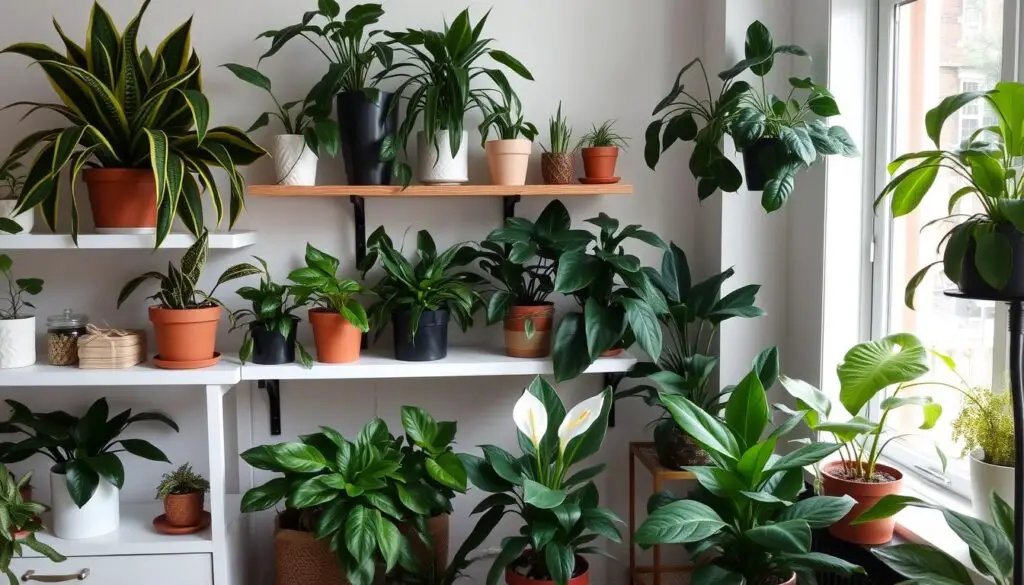
| Plant Type | Light Requirements | Watering Frequency | Humidity Requirements |
|---|---|---|---|
| ZZ Plant | Low to indirect light | Every 2-3 weeks | Low humidity |
| Snake Plant | Low to indirect light | Every 2-6 weeks | Low humidity |
| Peace Lily | Medium to low light | Once a week | High humidity |
| Pothos | Varies, thrives in low light | Every 1-2 weeks | Moderate humidity |
Adding these plants to your home makes it more welcoming. By trying different combinations, you can enjoy the beauty of indoor gardening, even in low-light areas.
Conclusion
Adding indoor plants for low light can really make a home feel better. They help clean the air and add some green to dark spots. The 13 best plants, like the ZZ Plant and Snake Plant, need little light and are easy to care for.
Choosing the right plants is key. Look for ones that grow slowly and have big leaves. They do well in low light. By placing them right, you can create a beautiful indoor garden. For more tips, check out this guide.
Using indoor plants for low light does more than just make your home look good. It also makes you feel better and less stressed. As you learn to care for these plants, you’ll enjoy the calm they bring. Make your home a greener, happier place with these plants.
FAQ
What defines low light in indoor gardening?
Low light means areas without direct sunlight. Think basements, north-facing rooms, and dim corners. These spots make plants grow slowly and can lead to too much water.
Which indoor plants are best suited for low light conditions?
Great plants for low light include the ZZ Plant and Snake Plants. The ZZ Plant has thick leaves and is very hardy. Snake Plants, like ‘Zeylanica’ and ‘Laurentii’, clean the air well. The Peace Lily also does well in low light and blooms beautifully.
How do indoor plants improve air quality?
Plants like Peace Lilies and Snake Plants clean the air. They take in bad stuff and give out oxygen. This makes the air healthier and fresher.
What are the signs of a struggling indoor plant?
If a plant looks sick, it might have yellow leaves, droopy stems, or grow slowly. These problems often come from too much water, not enough light, or bad soil.
What care techniques are necessary for low light plants?
To keep plants healthy, let the soil dry out before watering. Use soil that drains well and choose pots that fit the plant’s needs. This helps them grow well in low light.
How can I create a visually appealing low light garden?
To make a pretty low light garden, put plants in shaded spots or bright rooms with soft light. Mix plants for height, texture, and color. This makes the space look good and helps plants grow well together.
What are some cost-effective plant choices for low light conditions?
Affordable plants for low light include Lucky Bamboo, Snake Plants, and ZZ Plants. They need little care and grow well in dim places, saving you money on plants.
How can different textures and colors enhance my indoor space?
Using plants with different textures and colors makes spaces more interesting. Plants with various greens, silvers, or patterns add beauty and depth, even in dim areas.

